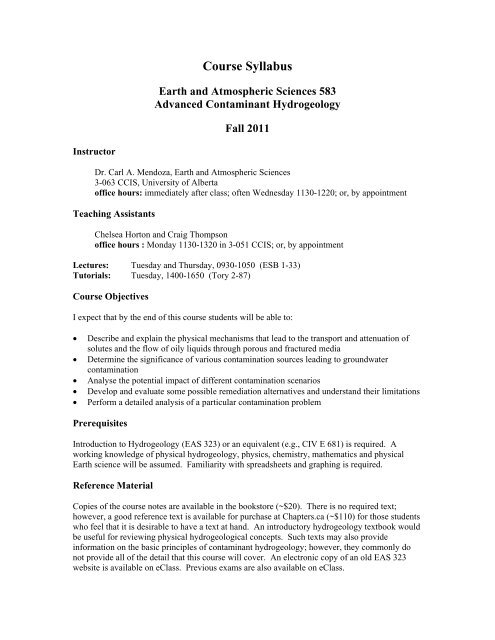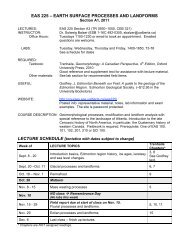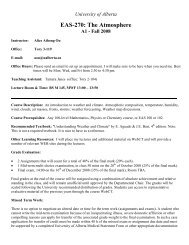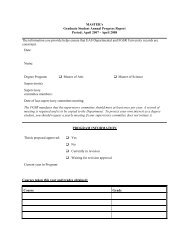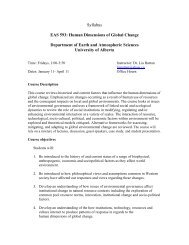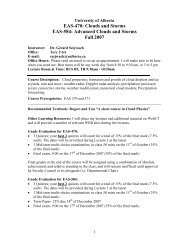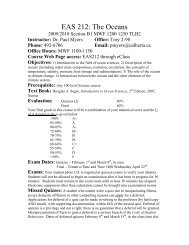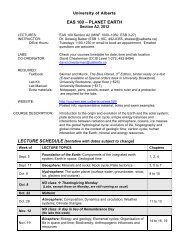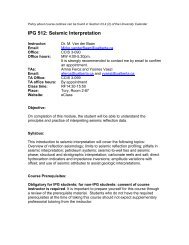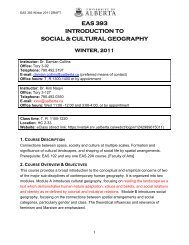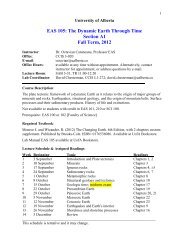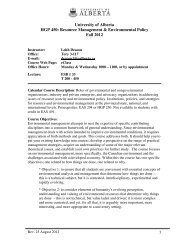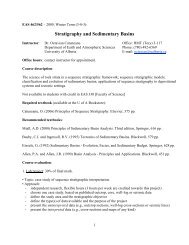Course syllabus - Earth and Atmospheric Sciences - University of ...
Course syllabus - Earth and Atmospheric Sciences - University of ...
Course syllabus - Earth and Atmospheric Sciences - University of ...
You also want an ePaper? Increase the reach of your titles
YUMPU automatically turns print PDFs into web optimized ePapers that Google loves.
<strong>Course</strong> Syllabus<strong>Earth</strong> <strong>and</strong> <strong>Atmospheric</strong> <strong>Sciences</strong> 583Advanced Contaminant HydrogeologyFall 2011InstructorDr. Carl A. Mendoza, <strong>Earth</strong> <strong>and</strong> <strong>Atmospheric</strong> <strong>Sciences</strong>3-063 CCIS, <strong>University</strong> <strong>of</strong> Alberta<strong>of</strong>fice hours: immediately after class; <strong>of</strong>ten Wednesday 1130-1220; or, by appointmentTeaching AssistantsChelsea Horton <strong>and</strong> Craig Thompson<strong>of</strong>fice hours : Monday 1130-1320 in 3-051 CCIS; or, by appointmentLectures: Tuesday <strong>and</strong> Thursday, 0930-1050 (ESB 1-33)Tutorials: Tuesday, 1400-1650 (Tory 2-87)<strong>Course</strong> ObjectivesI expect that by the end <strong>of</strong> this course students will be able to:• Describe <strong>and</strong> explain the physical mechanisms that lead to the transport <strong>and</strong> attenuation <strong>of</strong>solutes <strong>and</strong> the flow <strong>of</strong> oily liquids through porous <strong>and</strong> fractured media• Determine the significance <strong>of</strong> various contamination sources leading to groundwatercontamination• Analyse the potential impact <strong>of</strong> different contamination scenarios• Develop <strong>and</strong> evaluate some possible remediation alternatives <strong>and</strong> underst<strong>and</strong> their limitations• Perform a detailed analysis <strong>of</strong> a particular contamination problemPrerequisitesIntroduction to Hydrogeology (EAS 323) or an equivalent (e.g., CIV E 681) is required. Aworking knowledge <strong>of</strong> physical hydrogeology, physics, chemistry, mathematics <strong>and</strong> physical<strong>Earth</strong> science will be assumed. Familiarity with spreadsheets <strong>and</strong> graphing is required.Reference MaterialCopies <strong>of</strong> the course notes are available in the bookstore (~$20). There is no required text;however, a good reference text is available for purchase at Chapters.ca (~$110) for those studentswho feel that it is desirable to have a text at h<strong>and</strong>. An introductory hydrogeology textbook wouldbe useful for reviewing physical hydrogeological concepts. Such texts may also provideinformation on the basic principles <strong>of</strong> contaminant hydrogeology; however, they commonly donot provide all <strong>of</strong> the detail that this course will cover. An electronic copy <strong>of</strong> an old EAS 323website is available on eClass. Previous exams are also available on eClass.
Recommended text: Bedient, P.B., H.S. Rifai, <strong>and</strong> C.J. Newell, 1999. Ground WaterContamination, 2 nd Edition, Prentice Hall Upper Saddle River, New Jersey, 604p.<strong>Course</strong> OutlineThe expected order in which topics will be discussed is:1. Introduction (review <strong>of</strong> physical hydrogeology; conceptual models)2. Site Investigations, Sampling <strong>and</strong> Monitoring3. Physical Mass Transport in Saturated Porous Media4. Reactive Mass Transport in Saturated Porous Media5. Multiphase Flow in Saturated Porous Media6. Flow <strong>and</strong> Transport in Unsaturated <strong>and</strong> Fractured Media7. Remediation <strong>and</strong> Control TechniquesProblem AssignmentsThere will be eight problem assignments; assignment 8 will be worth twice as much as the others.If an assignment is not finished, all completed work should be submitted when it is due, normallyin the lab session (i.e., 1400 on Tuesday). Additional work (one set only) will be accepted late,subject to a 30% penalty, until 1700 the following day. Assignments will not be accepted formarks after this time. The TAs are not expected to assist with overdue assignments.Late (or early) assignments should be submitted to the appropriate slot in the hallway near Tory3-36. Assignments should not be submitted to either the instructor or a TA outside <strong>of</strong> the tutorialsession. Exceptions to the late policy will only be made for extenuating circumstances ifarrangements are made with the instructor, beforeh<strong>and</strong>.Tutorial sessions are designed to illustrate physical principles <strong>and</strong> calculations, to assist studentsin completing problem assignments <strong>and</strong> to review previous assignments or lecture material. Thefirst tutorial sessions will be during the week <strong>of</strong> September 19. There will be no tutorial the week<strong>of</strong> October 24.Assignment ExpectationsAs students start a graduate degree program, I expect that they should h<strong>and</strong> in neat <strong>and</strong> coherentwork that befits an advanced degree. A title page with your name, assignment number <strong>and</strong> title isrequired. Assignments should be submitted on paper <strong>of</strong> a reasonable quality, with writing ononly one side <strong>of</strong> the page. If pencil is used, ensure that it is dark enough to be legible. Questionnumbers must be clearly labelled <strong>and</strong> in the proper order (including figures <strong>and</strong> tables, ifappropriate). Assignment sheets should be stapled together (i.e., they should not be submitted induo-tangs, folders, binders, etc). Clearly indicate (e.g., by underlining, circling or highlighting)answers to numerical questions. Label graphs <strong>and</strong> tables appropriately. Up to 10% <strong>of</strong> the markfor each assignment may be deducted for poor style or organization, or consistent neglect <strong>of</strong>rudimentary principles (e.g., gross significant figure errors).Cooperative discussion <strong>of</strong> assignments is encouraged; however, each submitted assignment mustbe an original creation. Plagiarism <strong>and</strong>/or copying <strong>of</strong> (old or new) assignments will not betolerated <strong>and</strong> will lead to disciplinary action.
PaperThe primary difference between EAS 425 <strong>and</strong> 583 is that a term paper is required for EAS 583.The term paper may be a detailed literature review, execution <strong>and</strong> documentation <strong>of</strong> an originallaboratory or field experiment, a field site assessment or interpretation, etc. Deadlines:(1) Topics must be approved by the instructor by the end <strong>of</strong> September.(2) A detailed outline <strong>and</strong> list <strong>of</strong> primary resources must be submitted by the end <strong>of</strong> October.(3) Completed papers must be submitted by the last day <strong>of</strong> classes (early December).GradingEvaluation will be expressed in raw marks throughout the course. Grades will be assigned onlyto the final distribution <strong>of</strong> total marks for the course. Such assignments will be made at thediscretion <strong>of</strong> the instructor <strong>and</strong> will be based on a combination <strong>of</strong> absolute achievement <strong>and</strong>relative performance in this class <strong>and</strong> relative to previous classes.The following weighting will be used for assigning grades from raw scores:• assignments 35%• midterm exam (80 min) 15%• final exam (3 hr) 30%• term paper 20%All assignments must be completed to obtain full credit for the course; however, underextenuating circumstances, <strong>and</strong> prior arrangement, the instructor may excuse the completion <strong>of</strong>one assignment. Auditors, if permitted, must satisfactorily complete all assignments.Examinations will be cumulative. Students who are excused (e.g., due to illness) from themidterm exam will have the entire weight for the midterm added to the weight for the final.Other students who do not write the midterm exam will be assigned a mark <strong>of</strong> zero.The midterm exam will be held in class on Tuesday, October 25. Subject to modification orcorrection by the Registrar’s Office, the three-hour final examination will be held at 0900Wednesday, December 14. Deferred final exams, if approved by the Faculty <strong>of</strong> Science, will beheld at 0900 Thursday, February 23, 2012. These dates cannot be changed.eClasseClass will be used to enhance communication between the instructor, TAs <strong>and</strong> students. eClasswill primarily be used for posting marks, conferencing (including corrections <strong>and</strong> clarificationsto assignments), <strong>and</strong> course e-mail. Assignments will also be available.“Policy about course outlines can be found in Section 23.4(2) <strong>of</strong> the <strong>University</strong> Calendar.”“The <strong>University</strong> <strong>of</strong> Alberta is committed to the highest st<strong>and</strong>ards <strong>of</strong> academic integrity <strong>and</strong> honesty. Students areexpected to be familiar with these st<strong>and</strong>ards regarding academic honesty <strong>and</strong> to uphold the policies <strong>of</strong> the <strong>University</strong> inthis respect. Students are particularly urged to familiarize themselves with the provisions <strong>of</strong> the Code <strong>of</strong> StudentBehaviour (online at www.ualberta.ca/secretariat/appeals.htm) <strong>and</strong> avoid any behaviour which could potentially resultin suspicions <strong>of</strong> cheating, plagiarism, misrepresentation <strong>of</strong> facts <strong>and</strong>/or participation in an <strong>of</strong>fence. Academicdishonesty is a serious <strong>of</strong>fence <strong>and</strong> can result in suspension or expulsion from the <strong>University</strong>.”Last revision: 7 September 2011
<strong>Earth</strong> <strong>and</strong> <strong>Atmospheric</strong> <strong>Sciences</strong> 583Advanced Contaminant HydrogeologyTerm Paper GuidelinesA term paper is required for EAS 583. The primary requirement is that the term paperaddresses some issue relevant to transport in porous or fractured media. The term papermay be a detailed literature review, execution <strong>and</strong> documentation <strong>of</strong> an originallaboratory or field experiment, a field site assessment or interpretation, etc.Note the following deadlines:(1) Topics must be approved by the instructor by the end <strong>of</strong> September.(2) A detailed outline <strong>and</strong> list <strong>of</strong> primary resources must be submitted by the end <strong>of</strong>October.(3) Completed papers must be submitted by the last day <strong>of</strong> classes (early December).Reports must be word processed, using a 12 pt Times New Roman font, with 1.5 linespacing <strong>and</strong> 1” margins. (This text is 12 pt Times New Roman.) They should be printedone side <strong>and</strong> stapled in the upper left corner. Please do not use folders, duo-tangs orbindings <strong>of</strong> any kind.All references to the literature or the internet should be fully cited, in any consistentformat that you choose. Similarly, all figures from the literature or the internet mist befully referenced. For a literature review a couple dozen references might be appropriate.I expect that many papers will be about 25 to 45 pages, including figures, tables <strong>and</strong>references; however, there is no firm requirement. Papers should be <strong>of</strong> sufficient lengthto adequately explore your chosen topic. Very brief reports might indicate either asuperficial treatment or a topic that is too narrow; very long reports might indicate a topicthat is too broad.Papers should have an Abstract, Introduction, Body (e.g., Methods <strong>and</strong> Results, orSummary <strong>of</strong> Literature), Discussion, Conclusions <strong>and</strong> References. Figures <strong>and</strong> tablesshould be sequentially referenced in the text. They may be embedded in the text orplaced at the end <strong>of</strong> the document.Last revision: 7 September 2011
EAS 583 - Term Paper EvaluationVery PoorPoorFairSatisfactoryGoodExcellent0 1 2 3 4 5Technical ContentDepth <strong>and</strong> Focus 3Incorporation <strong>of</strong> <strong>Course</strong> Material 1Applicability to transport <strong>of</strong> contaminants 1Relevance <strong>of</strong> figures <strong>and</strong> diagrams 1EnglishOrganization 1Sentence structure <strong>and</strong> grammar 1ReferencesCitations <strong>and</strong> references to literature 1Figures <strong>and</strong> diagrams 1Total 10WeightMark50


